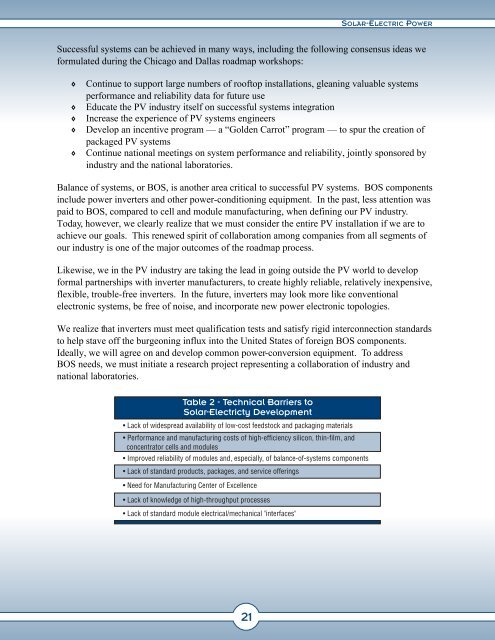Solar Electric Power -- The U.S. Photovoltaic Industry ... - Ecotopia
Solar Electric Power -- The U.S. Photovoltaic Industry ... - Ecotopia
Solar Electric Power -- The U.S. Photovoltaic Industry ... - Ecotopia
Create successful ePaper yourself
Turn your PDF publications into a flip-book with our unique Google optimized e-Paper software.
SOLAR-ELECTRIC POWER<br />
Successful systems can be achieved in many ways, including the following consensus ideas we<br />
formulated during the Chicago and Dallas roadmap workshops:<br />
� Continue to support large numbers of rooftop installations, gleaning valuable systems<br />
performance and reliability data for future use<br />
� Educate the PV industry itself on successful systems integration<br />
� Increase the experience of PV systems engineers<br />
� Develop an incentive program — a “Golden Carrot” program — to spur the creation of<br />
packaged PV systems<br />
� Continue national meetings on system performance and reliability, jointly sponsored by<br />
industry and the national laboratories.<br />
Balance of systems, or BOS, is another area critical to successful PV systems. BOS components<br />
include power inverters and other power-conditioning equipment. In the past, less attention was<br />
paid to BOS, compared to cell and module manufacturing, when defining our PV industry.<br />
Today, however, we clearly realize that we must consider the entire PV installation if we are to<br />
achieve our goals. This renewed spirit of collaboration among companies from all segments of<br />
our industry is one of the major outcomes of the roadmap process.<br />
Likewise, we in the PV industry are taking the lead in going outside the PV world to develop<br />
formal partnerships with inverter manufacturers, to create highly reliable, relatively inexpensive,<br />
flexible, trouble-free inverters. In the future, inverters may look more like conventional<br />
electronic systems, be free of noise, and incorporate new power electronic topologies.<br />
We realize that inverters must meet qualification tests and satisfy rigid interconnection standards<br />
to help stave off the burgeoning influx into the United States of foreign BOS components.<br />
Ideally, we will agree on and develop common power-conversion equipment. To address<br />
BOS needs, we must initiate a research project representing a collaboration of industry and<br />
national laboratories.<br />
Table 2 - Technical Barriers to<br />
<strong>Solar</strong>-<strong>Electric</strong>ty Development<br />
• Lack of widespread availability of low-cost feedstock and packaging materials<br />
• Performance and manufacturing costs of high-efficiency silicon, thin-film, and<br />
concentrator cells and modules<br />
• Improved reliability of modules and, especially, of balance-of-systems components<br />
• Lack of standard products, packages, and service offerings<br />
• Need for Manufacturing Center of Excellence<br />
• Lack of knowledge of high-throughput processes<br />
• Lack of standard module electrical/mechanical "interfaces"<br />
21


